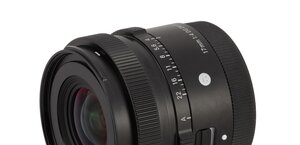Sigma A 24-70 mm f/2.8 DG OS HSM
4. Image resolution
Let's check how the next Art series Sigma lens compares here – its results in the frame centre at 24, 45 and 70 mm presents a graph below.
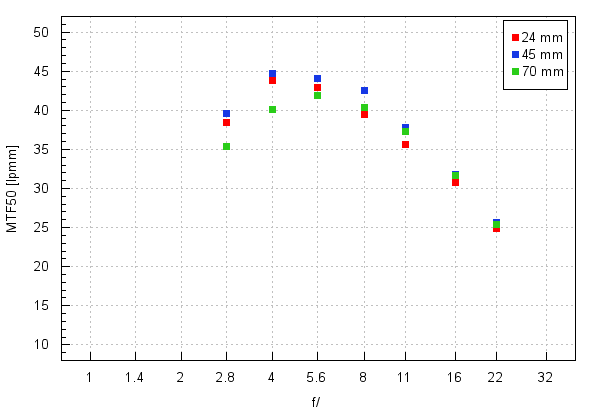
Shorter focal lenghs fare brilliantly well. Already at the maximum relative aperture the lens gets to almost 40 lpmm and on stopping down the aperture to f/4.0 the resolution increases to about 44 lpmm. The maximum focal length lags behind a bit but the differences aren't big so it still can be assessed very positively. After all the result at the maximum relative aperture still exceeds 35 lpmm and on stopping down the lens to near f/5.6 the MTFs get to 42 lpmm.
Please Support UsIf you enjoy our reviews and articles, and you want us to continue our work please, support our website by donating through PayPal. The funds are going to be used for paying our editorial team, renting servers, and equipping our testing studio; only that way we will be able to continue providing you interesting content for free. |
- - - - - - - - - - - - - - - - - - - - - - - - - - - - - - - - - - - - - - - - - - - - - - - -
How these values compare to the performance of the rivals? We think a comparison to two other stabilized 24-70 mm lenses so the Nikkor AF-S 24-70 MM F/2.8E ED VR and the Tamron SP 24–70 mm f/2.8 Di VC USD would be the fairest. The Sigma wins in both cases, being only slightly better than the Nikkor but significantly better than the Tamron, especially in the middle of the focal lengths range where the Tamron had a noticeable crisis. Still you must remember here we compare the tested lens to the old Tamron; the new one, presented at the end of June 2017 we haven't tested yet.
It should also be noticed that the results of the stabilized Sigma don't seem so impressive if compared to other non-stabilized rivals. The Nikkor AF-S 24–70 mm f/2.8G ED seems to be better than the Sigma at every focal length; the Canon EF 24–70 mm f/2.8L II USM also performs slightly better and even the Tokina AT-X PRO FX SD 24–70 mm f/2.8 (IF) might be assessed more favourably because it loses to the Sigma only at the combination of 45 mm and f/2.8, for the rest of parameters it fares similarly well or a bit better.
Now let's check the edge of the APS-C/DX sensor; an appropriate graph you can find below.
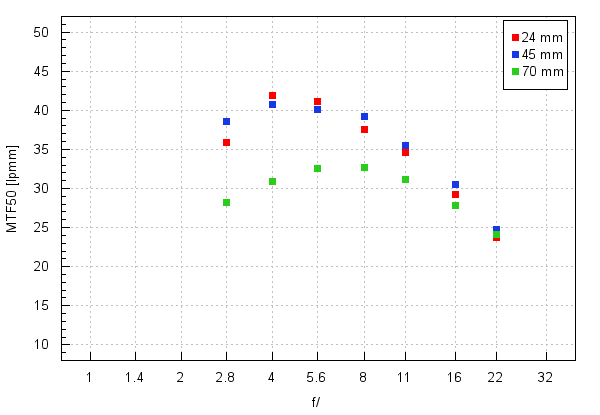
Once again the 24-45 mm range fares noticeably better than the longest focal length - here you can talk about very good results because at the maximum relative aperture they are able to exceed a level of 35 lpmm and on stopping down they are over 40 lpmm. Compared to that, the crisis at the maximum focal length is even more keenly felt. By f/2.8 the image is not useful at all and the lens needs to be stopped down to near f/4.0 to reach the level of usefullness. The stabilized Nikkor's performance was more even – its resolution values at the shorter end of the focal lengths spectrum were perhaps worse than those of the Sigma but at 70 mm it performed noticeably better so it had no weak points on the edge of the APS-C/DX sensor. The same can be said about the performance of the Canon 24-70 mm f/2.8 II and the Tokina 24-70 mm f/2.8 in this part of the frame. The stabilized Tamron can win a duel with the Sigma only at the maximum focal length and only on stopping down.
Now it's time to check the edge of full frame.
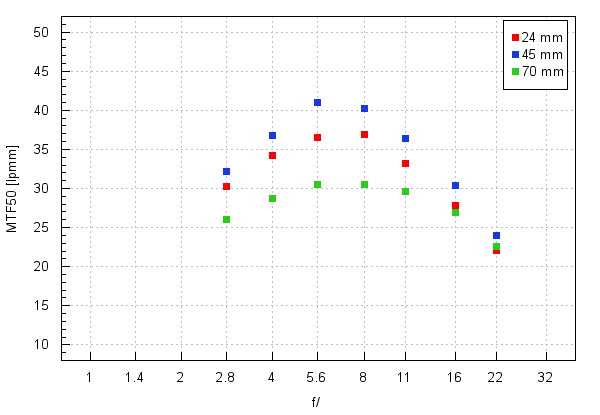
The discrepancies between all focal lengths are distinct here. The middle of the range fares the best, with a very good performance of the lens. It would be difficult to carp about the shortest focal length either as even with the lens wide open the results border useful level. Once again the 70 mm focal length is the weakest – only on stopping down the aperture to f/5.6 – 8.0 you see the resolution values brushing agains the useful level.
Still the rivals don't offer you more in this part of the frame. Only results of the Tokina can be assessed more positively; more expensive and the most modern Canon and Nikon constructions have weak points as well.
To sum up we kind of understand the idea behind this Sigma construction. The designers guaranteed an excellent image quality in the frame centre across the whole focal lenths range; on the edge the 24-45 mm range fares very well even on full frame but at the expense of the maximum focal length which is the weakest. It seems to be a sensible approach: exactly at the shorter focal lengths you need good sharpness across the frame but at 70 mm the edges are often blurry anyway.
At the end of this part of our test traditionally we present crops from photos of our resolution testing chart saved as JPEG files.
| Canon 5D MkIII, JPEG, 45 mm, f/4.0 |
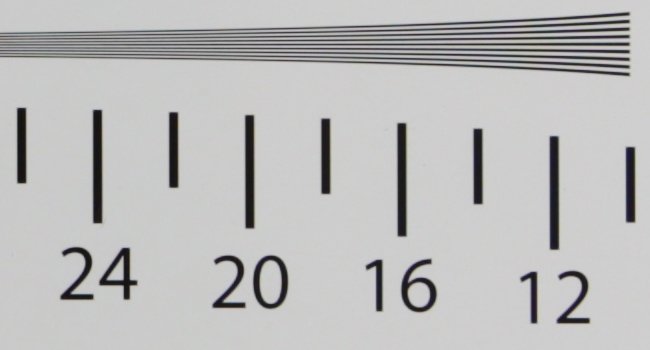 |
| Canon 5D MkIII, JPEG, 70 mm, f/2.8 |
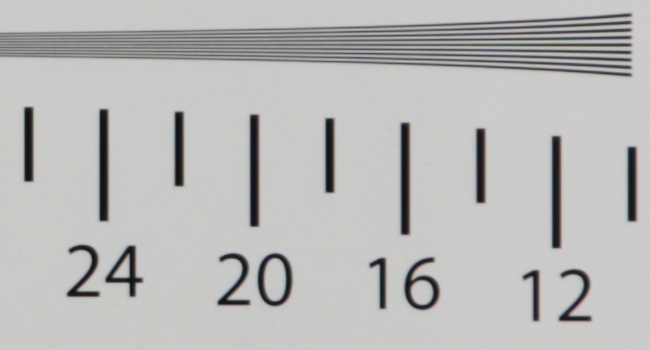 |





